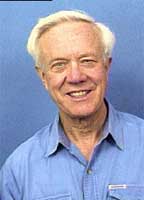启发式搜索算法引论------A*算法理论与实践
下面是作者的email:
EmilMatthew (EmilMatthew@126.com)
英文出处:http://blog.csdn.net/EmilMatthew/archive/2006/10/17/1338808.aspx
[ 类别 ]算法实践 ,人工智能
[推荐指数]★★★★★
[ 摘要 ]本文介绍了启发式算法中一种重要而有效的算法------A*算法的理论,并给出了寻路问题的交互式实现。
[ 关键词 ] A*,启发式算法,最优路径,交互式,AS2
Introduction to Heuristics Search------
A* Algorithm Principle and Practice
[Classify] Algorithm Implementation , Artificial Intelligence
[ Level ] ★★★★★
[Abstract] This article introduces an important and effective heuristics algorithm ------ A* algorithm with its theory and also gives out its interactive implementation of path finding problem.
[Key Words] A* , Heuristics Algorithm , Best Path Finding , Interactive , AS2
[1历史回顾]
P. E. Hart , N. J. Nilsson 和B. Raphael共同发表了一篇在启发式搜索方面有深远影响力的论文:
“P. E. Hart, N. J. Nilsson, and B. Raphael. A formal basis for the heuristic determination of minimum cost paths in graphs. IEEE Trans. Syst. Sci. and Cybernetics, SSC-4(2):100-107, 1968” 。从此,一种精巧、高效的算法------A*算法横空出世了,并在相关领域得到了广泛的应用。


Peter E. Hart Nils J. Nilsson
[2从DFS和BFS中来]
A*算法的思想来源并不是什么高深莫测的东西,事实上,它与我们所熟悉的另外两种搜索策略:DFS(深度优先Deep First Search)和 BFS(广度优先Breadth First Search)有着自然而紧密的联系。
首先要提一下搜索树的概念,一个可以搜索出某个可行解的问题,如“农夫、白菜、羊、狼”和“八皇后”等,虽然从表面上看上去和“树”这种结构无关,但是整个搜索过程中的可能试探点所行成的搜索空间总可以对应到一颗搜索树上去。所以,将各类形式上不同的搜索问题抽象并统一成为搜索树的形式,为算法的设计与分析带来巨大的方便。
下面,让我们通过两个Flash演示来回顾一下DFS和BFS的算法思想:
DFS算法思想演示:
BFS算法思想演示
重点要在这里说明是:
DFS和BFS在展开子结点时均属于盲目型搜索,也就是说,它不会选择哪个结点在下一次搜索中更优而去跳转到该结点进行下一步的搜索。在运气不好的情形中,均需要试探完整个解集空间, 显然,只能适用于问题规模不大的搜索问题中。
那么,作为启发式算法中的A*算法,又比它们高效在哪里呢?
首先要来谈一下什么是启发式算法。所谓启发式搜索,与DFS和BFS这类盲目型搜索最大的不同,就在于当前搜索结点往下选择下一步结点时,可以通过一个启发函数来进行选择,选择代价最少的结点作为下一步搜索结点而跳转其上(遇到有一个以上代价最少的结点,不妨选距离当前搜索点最近一次展开的搜索点进行下一步搜索)。一个经过仔细设计的启发函数,往往在很快的时间内就可得到一个搜索问题的最优解,对于NP问题,亦可在多项式时间内得到一个较优解。
A*算法,作为启发式算法中很重要的一种,被广泛应用在最优路径求解和一些策略设计的问题中。而A*算法最为核心的部分,就在于它的一个估值函数的设计上:
f(n)=g(n)+h(n)
其中f(n)是每个可能试探点的估值,它有两部分组成:一部分为g(n),它表示从起始搜索点到当前点的代价(通常用某结点在搜索树中的深度来表示)。另一部分,即h(n),它表示启发式搜索中最为重要的一部分,即当前结点到目标结点的估值,h(n)设计的好坏,直接影响着具有此种启发式函数的启发式算法的是否能称为A*算法。
一种具有f(n)=g(n)+h(n)策略的启发式算法能成为A*算法的充分条件是:
1) 搜索树上存在着从起始点到终了点的最优路径。
2) 问题域是有限的。
3)所有结点的子结点的搜索代价值>0。
4)h(n)=<h*(n) (h*(n)为实际问题的代价值)。
当此四个条件都满足时,一个具有f(n)=g(n)+h(n)策略的启发式算法能成为A*算法,并一定能找到最优解。([1]P89给出了相关的证明)
对于一个搜索问题,显然,条件1,2,3都是很容易满足的,而
条件4): h(n)<=h*(n)是需要精心设计的,由于h*(n)显然是无法知道的,
所以,一个满足条件4)的启发策略h(n)就来的难能可贵了。不过,对于图的最优路径搜索和八数码问题,有些相关策略h(n)不仅很好理解,而且已经在理论上证明是满足条件4)的,从而为这个算法的推广起到了决定性的作用。不过h(n)距离h*(n)的呈度不能过大,否则h(n)就没有过强的区分能力,算法效率并不会很高。对一个好的h(n)的评价是:h(n)在h*(n)的下界之下,并且尽量接近h*(n).
当然,估值函数的设计也就就仅仅是f(n)=g(n)+h(n)一种,另外的估值函数“变种”如:f(n)=w*g(n)+(1-w)*h(n) ,f(n)=g(n)+h(n)+h(n-1)针对不同的具体问题亦会有不同的效果。
[ 3A *算法的核心过程]
让我们先来通过两个Flash演示,来看一下A*算法在具体应用时的搜索树是如何展开的。
A* Search搜索树1
A* Search搜索树2
通过演示,我们可以看出:A*算法最为核心的过程,就在每次选择下一个当前搜索点时,是从所有已探知的但未搜索过点中(可能是不同层,亦可不在同一条支路上),选取f值最小的结点进行展开。而所有“已探知的但未搜索过点”可以通过一个按f值升序的队列(即优先队列)进行排列。这样,在整体的搜索过程中,只要按照类似广度优先的算法框架,从优先队列中弹出队首元素(f值),对其可能子结点计算g、h和f值,直到优先队列为空(无解)或找到终止点为止。
A*算法与广度优先和深度优先的联系就在于,当g(n)=0时,该算法类似于DFS,当h(n)=0时,该算法类似于BFS , 这一点,可以通过上面的A*搜索树的具体过程中将h(n)设为0或将g(n)设为0而得到。
A*算法实现框架:
重要数据解释:
Open Table :存放所有已探知的但未搜索过点的优先队列。
Closed Table :存在搜索过的点的数组,提取最优路径时有用。
Start Node :起始点。
Target Node :终止点。
C Node :当前点。
算法框架如下:
1.Init start node , add it to open table
While not reach target node && open table is unNull
2.a) Get the head node in open table->c node
2.b) Finding all c node’s possible child node.
2.c) Calculate each child node’s f value.
2.d) Remove c node from open table , add it to closed table.
2.e) Add all c node’s child nodes to open table in an undescend sequence.
Wend
3.Ouput Search Result
算法的实现部分参附录1(C Version),附录2(AS2 Version)
提取最优路径的算法并不复杂,虽然在CLOSE表中会有许多无效的搜索点,但是最优路径上各结点的下标一定是按照CLOSE表中下标的升序排列的。因此,只要在CLOSE表中,将下标从终止点向起始点移动,若CLOSE[i+1]与CLOSE[i]没有关联,则剔除CLOSE[i]。
[ 3A *算法在路径最优问题的交互式示例]
路径最优问题,简单来说,就是在两个结点之间找一条最短路径。有的朋友不禁要问,这个问题不是已经有Dijkstra算法可以解决了吗?此话不假,但是不要忘了Dijkstra算法的复杂度是O(n^2),一旦结点很多并且需要实时计算的话,Dijkstra就无法满足要求了。而A*来处理这类有需要实时要求的问题则显得游刃有余。
在路径最优问题中,用来作为启发函数关键部分的h(n)其实很容易选,那便是当前结点至最终结点的距离,这个距离既可以是Hamilton距离(|x1-x2|+|y1-y2|),亦可以是Euclid 距离(直线距离)。都可以在较快的速度下达到问题的最优解。
下面给出在Flash平台下,用AS2编制的交互式A*算法寻路问题的三个示例程序:(限于Flash的处理性能,当你点了一个目标点后,需要等卡通人物行进到该点时方可点下一点)
A* Test1
A* Test2
A* Test3
注:上面所示的三个Flash的最优路径搜索有时会出现走弯路的现象,系我这里的最优路径提取算法设计不佳所致(A*算法本身并没有错误),相应的改进请参考:A*算法最优解提取算法
[4]小结
本文不仅对A*算法的思想来源及核心部分作了较为详细的介绍,更重要的是,给出了A*算法在网络平台下的一种交互式实现,这一点具有创新意义。
这个程序的实现,不仅给我自己带去了快乐,相信也带给了更多朋友一点小小的启发,对此,我深感颀慰。当然,这个程序还可以在时实交互性上做得更好些,这是值得努力的方向。还有,A*算法本身亦有许多改进之处,如应对“陷井”时,如何更快的脱离,避免无畏的搜索,都是值得去展开的方向。
[参考文献与网站]
[0] 林尧瑞、马少平著,人工智能导论,清华大学出版社,2001.
[1] Nils J.Nilsson著,郑扣根等译,人工智能,机械工业出版社,2003
[2] http://ai.stanford.edu/users/nilsson/trweb/tr.html
[3] http://www.crc.ricoh.com/~hart/
[4] http://i11www.iti.uni-karlsruhe.de/~fschulz/shortest-paths/
程序完成日:06/10/15
文章完成日:06/10/17
附录[0]
A*算法核心部分之C语言版本:
void parseMap_AStar()
{
float tempG,tempF;
EPQ_DataType tempPoint;
int noFindingFlag;
int i;
int moreThanOneBlock;
int sIndex;
currentPoint=startPoint;
//early check
enQueue_EPQ(testQueue,currentPoint,LESS_THAN_VAL);
if(currentPoint->x==targetPoint->x&&
currentPoint->y==targetPoint->y)
goto LABEL_FOUNDED;
//Init for output data
CTCIndex=0;
NAIndex=0;
noFindingFlag=0;
moreThanOneBlock=0;
sIndex=0;
//core algorithm
while(!isEmpty_EPQ(testQueue))
{
currentPoint=deQueue_EPQ(testQueue);
//For natrual A* path finding answer output
CLOSETable[CTCIndex].x=currentPoint->pX;
CLOSETable[CTCIndex].y=currentPoint->pY;
NATable[NAIndex]=CLOSETable[CTCIndex];
CTCIndex++;NAIndex++;
//from current point ,look for the possible point to move.
//start from west ,clockwise
tempG=currentPoint->g+STEP_G;
//west
if(currentPoint->x>1&&
mapData[(int)currentPoint->y][(int)currentPoint->x-1]!=BLOCKED_GROUND&&
mapData[(int)currentPoint->y][(int)currentPoint->x-1]!=LABELED)
{
//target pos check if(currentPoint->x-1==targetPoint->x&&
currentPoint->y==targetPoint->y)
{ currentPoint->pX=currentPoint->x;
currentPoint->pY=currentPoint->y;
currentPoint->x=currentPoint->x-1;
goto LABEL_FOUNDED;
}
tempF=calDis(currentPoint->y,currentPoint->x-1);
tempPoint=createAPoint(currentPoint->x-1,currentPoint->y);
tempPoint->pX=currentPoint->x;
tempPoint->pY=currentPoint->y;
setAStarValue(tempPoint,tempF,tempG);
enQueue_EPQ(testQueue,tempPoint,LESS_THAN_VAL);
mapData[(int)currentPoint->y][(int)currentPoint->x-1]=LABELED;
}
//north
if(currentPoint->y>1&&
mapData[(int)currentPoint->y-1][(int)currentPoint->x]!=BLOCKED_GROUND&&
mapData[(int)currentPoint->y-1][(int)currentPoint->x]!=LABELED)
{
//target pos check if(currentPoint->x==targetPoint->x&&
currentPoint->y-1==targetPoint->y)
{ currentPoint->pX=currentPoint->x;
currentPoint->pY=currentPoint->y;
currentPoint->y=currentPoint->y-1;
goto LABEL_FOUNDED;
}
tempF=calDis(currentPoint->y-1,currentPoint->x);
tempPoint=createAPoint(currentPoint->x,currentPoint->y-1);
tempPoint->pX=currentPoint->x;
tempPoint->pY=currentPoint->y;
setAStarValue(tempPoint,tempF,tempG);
enQueue_EPQ(testQueue,tempPoint,LESS_THAN_VAL);
mapData[(int)currentPoint->y-1][(int)currentPoint->x]=LABELED;
}
//east
if(currentPoint->x<mapWidth-1&&
mapData[(int)currentPoint->y][(int)currentPoint->x+1]!=BLOCKED_GROUND&&
mapData[(int)currentPoint->y][(int)currentPoint->x+1]!=LABELED)
{
//target pos check if(currentPoint->x+1==targetPoint->x&&
currentPoint->y==targetPoint->y)
{
currentPoint->pX=currentPoint->x;
currentPoint->pY=currentPoint->y;
currentPoint->x=currentPoint->x+1;
goto LABEL_FOUNDED;
}
tempF=calDis(currentPoint->y,currentPoint->x+1); tempPoint=createAPoint(currentPoint->x+1,currentPoint->y);
tempPoint->pX=currentPoint->x;
tempPoint->pY=currentPoint->y;
setAStarValue(tempPoint,tempF,tempG);
enQueue_EPQ(testQueue,tempPoint,LESS_THAN_VAL);
mapData[(int)currentPoint->y][(int)currentPoint->x+1]=LABELED;
}
//south
if(currentPoint->y<mapHeight-1&&
mapData[(int)currentPoint->y+1][(int)currentPoint->x]!=BLOCKED_GROUND&&
mapData[(int)currentPoint->y+1][(int)currentPoint->x]!=LABELED)
{
//target pos check if(currentPoint->x==targetPoint->x&&
currentPoint->y+1==targetPoint->y)
{
currentPoint->pX=currentPoint->x;
currentPoint->pY=currentPoint->y;
currentPoint->y=currentPoint->y+1;
goto LABEL_FOUNDED;
}
tempF=calDis(currentPoint->y+1,currentPoint->x);
tempPoint=createAPoint(currentPoint->x,currentPoint->y+1);
tempPoint->pX=currentPoint->x;
tempPoint->pY=currentPoint->y;
setAStarValue(tempPoint,tempF,tempG);
enQueue_EPQ(testQueue,tempPoint,LESS_THAN_VAL);
mapData[(int)currentPoint->y+1][(int)currentPoint->x]=LABELED;
}
}
LABEL_FOUNDED:
CLOSETable[CTCIndex].x=currentPoint->pX;
CLOSETable[CTCIndex].y=currentPoint->pY;
NATable[NAIndex]=CLOSETable[CTCIndex];
CTCIndex++;NAIndex++;
CLOSETable[CTCIndex].x=currentPoint->x;
CLOSETable[CTCIndex].y=currentPoint->y;
NATable[NAIndex]=CLOSETable[CTCIndex];
CTCIndex++;NAIndex++;
//PROCESS OF ANSTable.
ANSTable[0]=CLOSETable[CTCIndex-1];
ANSIndex=1;
i=CTCIndex-2;
do
{
//ARBITARY OF NEAR BY POINT
if(
(CLOSETable[i].x-1==ANSTable[ANSIndex-1].x&&CLOSETable[i].y==ANSTable[ANSIndex-1].y)||
(CLOSETable[i].x==ANSTable[ANSIndex-1].x&&CLOSETable[i].y-1==ANSTable[ANSIndex-1].y)||
(CLOSETable[i].x+1==ANSTable[ANSIndex-1].x&&CLOSETable[i].y==ANSTable[ANSIndex-1].y)||
(CLOSETable[i].x==ANSTable[ANSIndex-1].x&&CLOSETable[i].y+1==ANSTable[ANSIndex-1].y))
{
ANSTable[ANSIndex]=CLOSETable[i];
ANSIndex++;
}
i--;
}while(!(CLOSETable[i].x==startPoint->x&&CLOSETable[i].y==startPoint->y));
//Output CLOSE table and NATRUAL table … …
}
------------
Lff 发表于2006-10-18 10:45:00 IP: 202.99.4.*
| A* 算法很好,但是实际上并不是很好用,因为如果不能说明h(n)<h*(n),就不能说是A*算法只能说是A算法。而A算法只能保证得到解,但是不一定是最优解。而证明h(n)<h*(n)是很困难的一件事,因为如果h*(n)都知道了就用不着搜索了。对于通常的问题,BFS基本上是够用的,其改进的双向广度优先搜索,也是很好的算法,并且保证得到最优解。 |
d79151028 发表于2007-05-07 20:21:03 IP: 58.100.77.*
| 这个算出来的可能不是最优路径 <row>1,1,1,1,1,1,1,1,1,1,1</row> <row>1,0,1,0,0,0,1,0,0,0,1</row> <row>1,0,1,0,0,0,1,0,1,0,1</row> <row>1,0,1,0,0,0,1,0,1,0,1</row> <row>1,0,1,0,0,0,0,0,1,0,1</row> <row>1,0,1,0,1,0,0,0,1,0,1</row> <row>1,0,0,0,1,0,0,0,1,0,1</row> <row>1,1,1,1,1,1,1,1,1,1,1</row> 试试这地图,左上到右下 |
| 其实最优路径是出来的,还是在提取上有些小问题,因为这个用例产生了一些“竞争”,解决的方法我还得想想。 不过,有个比较方便的改法,就是加强广度优先,把STEP_G改成0.7就ok了,但这不能保证更加tricky的用例是否能找到最短路径。 http://www.newdreamworks.com/emilmatthew/MyPapers/0632AStar/test.html |
Trackback: http://tb.blog.csdn.net/TrackBack.aspx?PostId=1338808






















 4691
4691

 被折叠的 条评论
为什么被折叠?
被折叠的 条评论
为什么被折叠?








